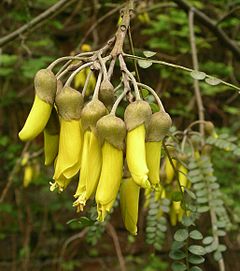Sophora
| Sophora subsp. var. | ||||||||||||||||||||||||||||||||||||||||||||||||||||||||
|---|---|---|---|---|---|---|---|---|---|---|---|---|---|---|---|---|---|---|---|---|---|---|---|---|---|---|---|---|---|---|---|---|---|---|---|---|---|---|---|---|---|---|---|---|---|---|---|---|---|---|---|---|---|---|---|---|

|
|
| ||||||||||||||||||||||||||||||||||||||||||||||||||||||
| ||||||||||||||||||||||||||||||||||||||||||||||||||||||||
Sophora is a genus of about 45 species of small trees and shrubs in the subfamily Faboideae of the pea family, Fabaceae. The species are native to southeast Europe, southern Asia, Australasia, the islands of the Pacific Ocean and western South America. The generic name is derived from sophera, an Arabic name for a pea-flowered tree.[1]
The genus formerly had a broader interpretation including many other species now treated in other genera, notably Styphnolobium (pagoda tree genus), which differs in lacking nitrogen fixing bacteria (rhizobia) on the roots, and Calia (the mescalbeans). Styphnolobium has galactomannans as seed polysaccharide reserve, in contrast Sophora contains arabinogalactans, and Calia amyloid.
The New Zealand Sophora species are known as Kowhai.
The Toromiro (Sophora toromiro) was formerly a common tree in the forests of Easter Island. The tree fell victim to the deforestation that eliminated the island's forests by the 18th century, and later became extinct in the wild. The tree is being reintroduced to the island in a scientific project partly led jointly by the Royal Botanic Gardens, Kew and the Göteborg Botanical Garden, where the only remaining plants of this species with a documented origin were propagated in the 1960s from seeds collected by Thor Heyerdahl.
Mayo or Mayú (Sophora macrocarpa) is a small tree that inhabits the Chilean Matorral.
| Standard Cyclopedia of Horticulture |
|---|
|
Sophora (Sophera, Arabian name of a tree with pea-shaped flowers). Including Styphnolobium and Edwardsia. Leguminosae. Ornamental woody or rarely herbaceous plants grown chiefly for their attractive flowers and handsome foliage. Deciduous or evergreen useful ornamental plants: lvs. alternate, odd-pinnate with opposite usually small entire lfts.: fls. pea-like, in racemes or terminal leafy panicles; calyx with 5 short teeth; standard orbicular or broadly obovate; stamens 10, free or connate only at the base: pod stalked, almost terete or 4-winged, rarely compressed, few- to many-seeded, moniliform, indehiscent or tardily dehiscent.—About 25 species in the temperate and subtropical regions of both hemispheres. The fls. and frs. of S. japonica yield a yellow dye, S. tomentosa has medicinal properties, and the seeds of S. secundiflora contain sophorine, a poisonous alkaloid. S. tetraptera is a valuable timber tree in its native country. The sophoras are handsome trees, rarely shrubs or herbs with graceful foliage, evergreen in some species, and with papilionaceous whitish, violet or pink, or yellow flowers in terminal panicles or in racemes, followed by long and narrow moniliform pods. Sophora japonica and the shrubby S. viciifolia are hardy as far north as Massachusetts, while S. affinis is less hardy. The evergreen species are tender and can be grown only in the southern states and California; they are very showy in spring when they are in bloom; in England they are often planted against a wall, where they can be easily protected against light frost. S. japonica is especially valuable for its late-appearing flowers, which are white and disposed in ample panicles; the foliage is dark green and graceful and the tree is conspicuous in winter on account of its dark green branches. It is sometimes planted as a street tree, as it stands heat and drought well. The sophoras thrive best in well-drained sandy loam but grow fairly well in rather dry soil. Propagation is by seeds and the varieties by grafting on the typical form; some species are also increased by greenwood cuttings and by layers. S. alopecuroides, Linn. Grayish-pubescent undershrub, with upright, virgate branches: lvs. 6 in. long, with 15-25 oblong lfts.: fls. yellow: racemes dense, terminal, about 6 in. long: pod terete, 6-12-seeded. W. Asia to Himalayas. Half-hardy.—S. australis, Linn.-Baptisia australis.—S. platycarpa, Maxim. -Cladrastis platycarpa.—S. tomentosa, Linn. Pubescent shrub: lvs. 6-10 in. long; lfts. 15-19, oval to oblong, obtuse, 1-1 3/4 in. long: fls. yellow, in terminal 6-12-in. long racemes: pod 4-6 in. long. Southern states, W. India.Not hardy North. CH
|
Cultivation
Propagation
Pests and diseases
Species
Selected species:
Gallery
References
- ↑ Gledhill, D. (2008). The Names of Plants (4 ed.). Cambridge University Press. p. 356. ISBN 9780521866453. http://books.google.com/books?id=NJ6PyhVuecwC.
- ↑ cited as S.viciifolia Hance (1903)in Tsong et Ma (1981)Acta Phytotaxonomica Sinica p.21
